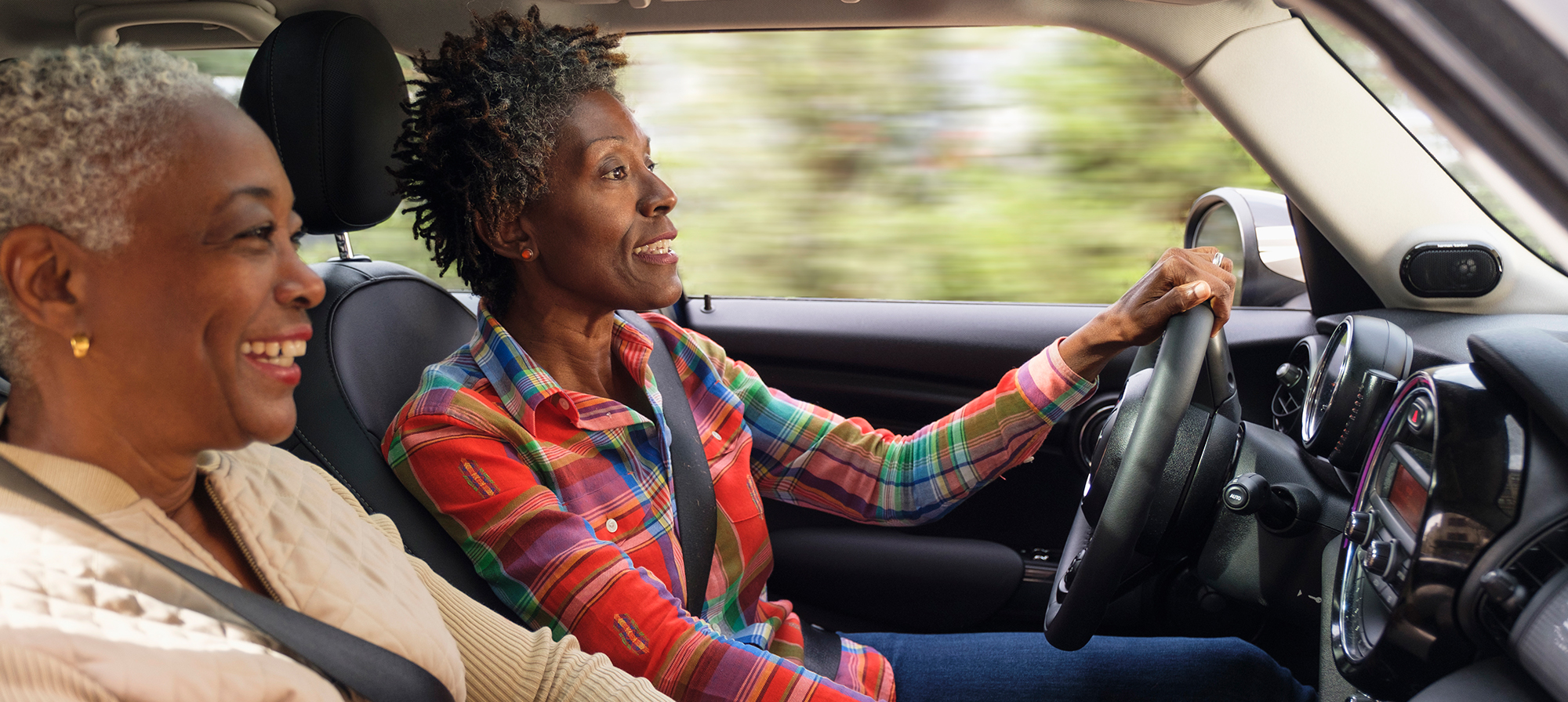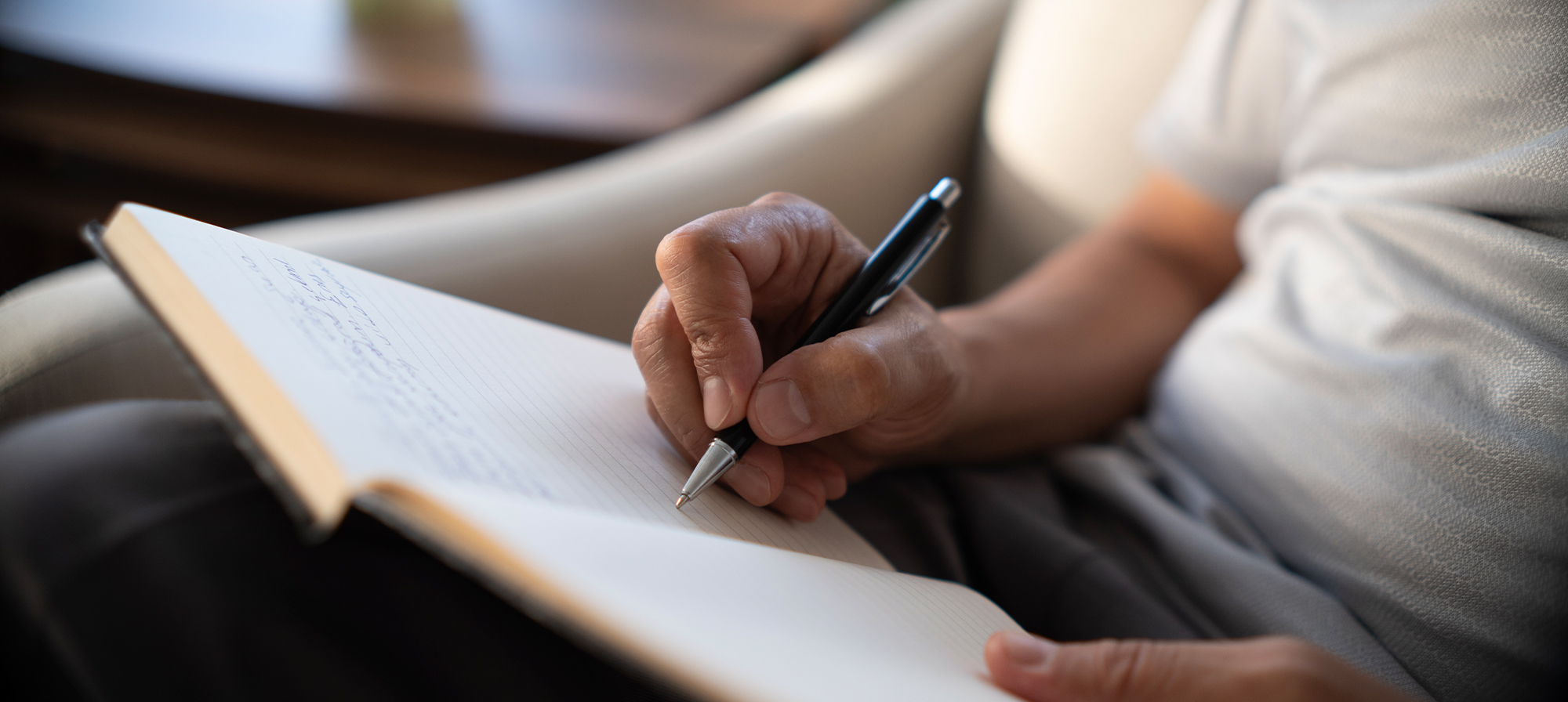If you’re gearing up for a road trip this holiday season, stay safe by outfitting your car with an emergency kit before you leave.
Nothing seems to draw friends and family together like the holidays. If you’re planning a road trip this holiday season, consider putting together an emergency kit to keep in your car. Even though some things—like the weather, natural disasters, or car accidents—may be out of your control, an emergency car kit can help minimize the stress of these unforeseen situations. And it can help keep a minor setback on the road from becoming a major problem. It can also help keep you safe.
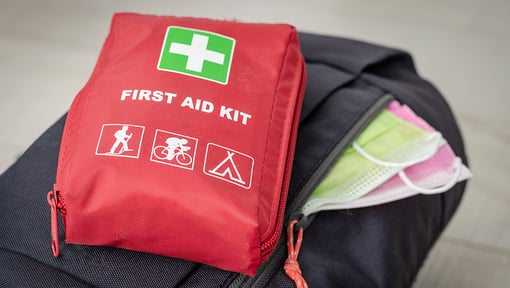
Putting together an emergency car kit
You can purchase a ready-made kit, but you might be better off putting your own kit together. It will likely cost less to do so. And customizing your own kit can also help ensure you have everything you need.
Here's a list to help you get started:
- Food and water. Even if you plan on stopping at every roadside diner you see along the way, always pack some extra food and water. Nonperishable, high-energy foods like dried fruits, nuts, and energy bars (without too many additives or preservatives) are a good option. And bring more water than you think you’ll need. Better to have too much than not enough.
- Jumper cables or battery-powered jump-starter. Should your car battery die, it’s crucial that you have a way to jump-start it. Jumper cables work great, but you’ll need help from another motorist to get the job done.
You may want to pick up a battery-powered jump-starter instead. These portable power packs have enough juice to jump-start a vehicle several times. Just be sure to fully charge the battery pack before you leave.
If you drive an electric car, you shouldn’t have any trouble finding charging stations in cities, but they are scarcer on the open road. Map out your route ahead of time. You might want to double check that these stations are in service before you leave. You don’t want to roll into a charging station with a nearly empty battery only to find out that charging station is not in operation. - Portable charger. While your battery-powered jump-starter can often double as a charger for your electronic devices, you may want to save that for emergencies only. A portable charger, on the other hand, is a small external battery that you can use to recharge your cell phone or electronic devices. Larger sizes allow for multiple charges.
- First aid kit. You can purchase a small first aid kit that should have most everything you need. It’s good to include gauze, wrapping tape, bandages, antibiotic ointment, over-the-counter pain relievers, nonlatex gloves, scissors, hydrocortisone, thermometer, tweezers, instant cold compress, and hand sanitizer.
- Road safety gear. If your car breaks down or you get a flat tire, it’s crucial that other motorists can clearly see you on the side of the road. So, pack some glow sticks, reflective road triangles, and a high-visibility vest.
- Flashlights or headlamps. If you need to change a tire or jump-start your battery after dark, you’ll want some portable lights. Headlamps may be your best option because they allow you to keep your hands free. Pack one for each person in your car. Don’t forget to pack a few extra batteries as well. Or, if they are rechargeable, charge them fully before you leave, and bring the USB cable to recharge them on the road if you need to.
- Basic toolkit. Depending on your mechanical skills, you can decide how expansive your toolkit needs to be. At the very least, be sure you have a lug wrench and a jack. But it never hurts to add a couple of screwdrivers, a socket set, pliers, and a multi-tool with a pocketknife. Some strong plastic zip ties and duct tape can also be a big help.
- Fire extinguisher. Hopefully, you’ll never need to use this, but it’s good to keep one on hand. Look for an extinguisher that can handle class B or class C fires. These are specifically for extinguishing fires caused by gasoline, oil, or electrical components. You will want to keep this securely attached directly under the driver’s seat for easy access in case of an emergency.
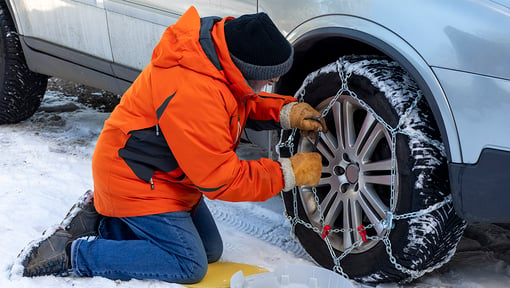
Special items when traveling in cold weather regions
If you’re visiting colder parts of the country, you’ll want to take a few additional precautions—especially if you’re unaccustomed to driving in cold, snowy weather.
- Items to keep you warm and dry. Even if you’re just driving through a cold weather region, make sure you’ve got some warm clothes packed in case of a breakdown or bad weather. This might include waterproof jackets, beanies, gloves, and closed-toe shoes. Also, bring extra wool blankets and some lightweight thermal Mylar blankets. Together, these protect best against freezing temperatures.
- Small, collapsible shovel to dig out of snow or ice.
- Ice scraper and snow brush.
- Bag of sand should you need a little traction for your tires in icy spots.
- Extra container of windshield wiper fluid.
- Snow tires or snow chains. You should only need these if you’re headed for mountainous regions, so check before you leave to see whether you’ll need them. Some areas won’t even let you pass through unless you have them.
- A spare tire. Keeping a spare tire in your trunk for all your travels, not just your snowy adventures, is a smart idea.
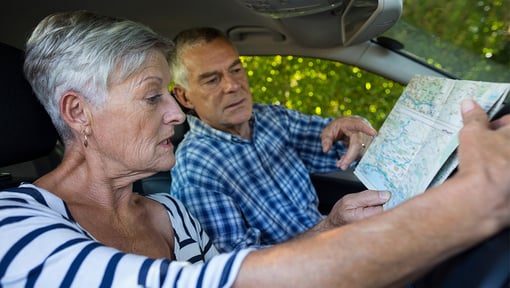
Don’t rely solely on your smartphone
Smartphones have helped make traveling easier and more convenient than ever. But if you’re passing through the middle of nowhere, you may have a weak cell signal or none at all.
Without cell service your phone won’t be able to guide you. And on the off chance you lose or break your phone, you’ll need a back-up plan. Here are a few suggestions:
- Buy some maps. If your phone’s GPS isn’t functioning, you’ll be out of luck trying to use turn-by-turn navigation. It’s a smart idea to keep a road atlas in your car. At the very least, pick up some paper maps of the states you’ll be driving through and plan out your route in advance.
- Print out a list of phone numbers of your friends and family. It’s probably been ages since you’ve memorized anyone’s phone number. In case you can’t access your phone, make sure you have this list of important phone numbers handy.
- Let family and friends know your vacation plans. As thrilling as it may be to spontaneously hit the open road, make sure at least a few of your friends or loved ones have a rough idea of your travel plans.
- Keep some cash on you. It’s possible you will use your credit or debit card for all your purchases and maybe even accrue some points to help get a free hotel room along the way. But don’t forget to bring a little cash with you just in case.

Look into using a roadside assistance service
In addition to your emergency car kit, having access to a roadside assistance service is vital. Roadside assistance services have dispatchers who can send a mechanic to you to help repair a flat tire, jump-start a dead battery, deliver gas if your tank runs dry, unlock your door, or give you a tow should you need one.
Your insurance company may even provide this service with your plan. Take a look at your coverage and see if it’s offered. If not, you may want to purchase a package.
Packing your road trip car kit
If your car is already stuffed to the max with luggage, this may seem like a lot of extra stuff to bring with you that you might not even need. But it’s worth it in the event of a road trip emergency.
Many of these items can be packed well in advance and stored in a duffel bag in your garage. Then you can just grab them when you’re ready to hit the road. Some items you may even want to keep in your car year-round, so that you’ll always have them on hand if you need them.
Once you get into the habit of preparing before each trip, you’ll wonder how you ever traveled without doing it. Sometimes you can’t put a price on peace of mind.
For more information about preparing for any kind of emergency, be sure to check out www.Ready.gov.
Not a Silver&Fit® member? Learn more about everything the program has to offer, including more helpful healthy living tips like this, here on our website.
This information is not intended to take the place of regular medical care or advice. Please check with your doctor before using this information or beginning any self-care program. Images used for this article do not depict any members of the Silver&Fit Program.
References
Mayo Clinic. (2023, May 13). Emergency essentials: Putting together a survival kit. https://www.mayoclinic.org/first-aid/emergency-essentials/basics/art-20134335
National Safety Council. (n.d.). What should you keep in the car? https://www.nsc.org/community-safety/safety-topics/emergency-preparedness/emergency-supplies-for-car
U.S. Department of Transportation. (2020). Learn the facts about new cars: Why newer cars are safer than ever before. National Highway Traffic Safety Administration https://www.nhtsa.gov/sites/nhtsa.gov/files/documents/newer-cars-safer-cars_fact-sheet_010320-tag.pdf
U.S. Fire Administration. (2023, March 22). Vehicle Fire Safety. https://www.usfa.fema.gov/prevention/vehicle-fires/
This article was written by Jason Nielsen, edited by Gail Olson, and clinically reviewed by Elizabeth Thompson, MPH, RDN, on June 4, 2025.
